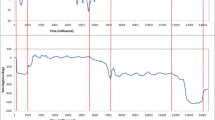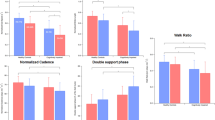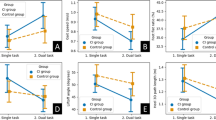Abstract
The “Timed Up and Go” (TUG) test is widely used in various disorders to evaluate subject’s mobility, usually evaluating only time execution. TUG test specificity could be improved by using instrumented assessment based on inertial sensors. Position of the sensor is critical. This study aimed to assess the reliability and validity of an inertial sensor placed in three different positions to correctly segment the different phases in the TUG test. Finding demonstrated good reliability of the proposed methodology compared to the gold standard motion analysis approach based on surface markers and an optoelectronic system. Placing the sensor just beneath the lumbar-sacral joint reported the lower values of deviation with respect to the gold standard. Optimized position can extend the proposed methodology from the clinical context towards ubiquitous solutions in an ecological approach.
Access this chapter
Tax calculation will be finalised at checkout
Purchases are for personal use only
Similar content being viewed by others
References
Mathias, S., Nayak, U.S., Isaacs, B.: Balance in elderly patients: the “get-up and go” test. Arch. Phys. Med. Rehabil. 67, 387–389 (1986)
Podsiadlo, D., Richardson, S.: The timed “Up & Go”: a test of basic functional mobility for frail elderly persons. J. Am. Geriatr. Soc. 39, 142–148 (1991)
Bloem, B.R., Marinus, J., Almeida, Q., Dibble, L., Nieuwboer, A., Post, B., Ruzicka, E., Goetz, C., Stebbins, G., Martinez-Martin, P., Schrag, A.: Movement disorders society rating scales committee: measurement instruments to assess posture, gait, and balance in Parkinson’s disease: critique and recommendations. Mov. Disord. 31(9), 1342–1355 (2016)
Cardon-Verbecq, C., Loustau, M., Guitard, E., Bonduelle, M., Delahaye, E., Koskas, P., Raynaud-Simon, A.: Predicting falls with the cognitive timed up-and-go dual task in frail older patients. Ann. Phys. Rehabil. Med. 60, 83–86 (2016)
Timmermans, C., Roerdink, M., van Ooijen, M.W., Meskers, C.G., Janssen, T.W., Beek, P.J.: Walking adaptability therapy after stroke: study protocol for a randomized controlled trial. Trials 17, 425 (2016)
Gautschi, O.P., Joswig, H., Corniola, M.V., Smoll, N.R., Schaller, K., Hildebrandt, G., Stienen, M.N.: Pre-and postoperative correlation of patient-reported outcome measures with standardized Timed Up and Go (TUG) test results in lumbar degenerative disc disease. Acta Neurochir. (Wien) 158, 1875–1881 (2016)
Gautschi, O.P., Corniola, M.V., Joswig, H., Smoll, N.R., Chau, I., Jucker, D., Stienen, M.N.: The timed up and go test for lumbar degenerative disc disease. J. Clin. Neurosci. 22, 1943–1948 (2015)
Kristensen, M.T., Bandholm, T., Holm, B., Ekdahl, C., Kehlet, H.: Timed Up & Go test score in patients with hip fracture is related to the type of walking aid. Arch. Phys. Med. Rehabil. 90, 1760–1765 (2009)
Weiss, A., Mirelman, A., Giladi, N., Barnes, L.L., Bennett, D.A., Buchman, A.S., Hausdorff, J.M.: Transition between the timed up and go turn to sit subtasks: is timing everything? J. Am. Med. Dir. Assoc. 17, 864.e9–864.e15 (2016)
Reinfelder, S., Hauer, R., Barth, J., Klucken, J., Eskofier, B.M.: Timed Up-and-Go phase segmentation in Parkinson’s disease patients using unobtrusive inertial sensors. Proc. Conf. IEEE Eng. Med. Biol. Soc. EMBS, 5171–5174 (2015)
Mellone, S., Tacconi, C., Chiari, L.: Validity of a smartphone-based instrumented Timed Up and Go. Gait Posture 36, 163–165 (2012)
Salarian, A., Horak, F.B., Zampieri, C., Carlson-Kuhta, P., Nutt, J.G., Aminian, K.: iTUG, a sensitive and reliable measure of mobility. IEEE Trans. Neural Syst. Rehabil. Eng. 18, 303–310 (2010)
Smith, E., Walsh, L., Doyle, J., Greene, B., Blake, C.: The reliability of the quantitative timed up and go test (QTUG) measured over five consecutive days under single and dual-task conditions in community dwelling older adults. Gait Posture 43, 239–244 (2016)
Van Lummel, R.C., Walgaard, S., Hobert, M.A., Maetzler, W., Van Dieën, J.H., Galindo-Garre, F., Terwee, C.B.: Intra-rater, inter-rater and test-retest reliability of an instrumented Timed Up and Go (iTUG) test in patients with Parkinson’s disease. PLoS One 11, 1–11 (2016)
Coulthard, J.T., Treen, T.T., Oates, A.R., Lanovaz, J.L.: Evaluation of an inertial sensor system for analysis of Timed-Up-and-Go under dual-task demands. Gait Posture 41, 882–887 (2015)
Zampieri, C., Salarian, A., Carlson-Kuhta, P., Aminian, K., Nutt, J.G., Horak, F.B.: The instrumented timed up and go test: potential outcome measure for disease modifying therapies in Parkinson’s disease. J. Neurol. Neurosurg. Psychiatry 81, 171–176 (2010)
Mancini, M., Priest, K.C., Nutt, J.G., Horak, F.B.: Quantifying freezing of gait in Parkinson’s disease during the instrumented timed up and go test. Conf. Proc. Annu. Int. Conf. IEEE Eng. Med. Biol. Soc., 1198–201 (2012)
Sheehan, K.J., Greene, B.R., Cunningham, C., Crosby, L., Kenny, R.A.: Early identification of declining balance in higher functioning older adults, an inertial sensor based method. Gait Posture 39, 1034–1039 (2014)
Greene, B.R., Doheny, E.P., O’Halloran, A., Kenny, R.A.: Frailty status can be accurately assessed using inertial sensors and the TUG test. Age Ageing 43, 406–411 (2014)
Lockhart, T.E., Yeoh, H.T., Soangra, R., Jongprasithporn, M., Zhang, J., Wu, X., Ghosh, A.: Non-invasive fall risk assessment in community dwelling elderly with wireless inertial measurement units. Biomed. Sci. Instrum. 48, 260–267 (2012)
Zakaria, N.A., Kuwae, Y., Tamura, T., Minato, K., Kanaya, S.: Quantitative analysis of fall risk using TUG test. Comput. Methods Biomech. Biomed. Engin. 5842, 37–41 (2013)
Greene, B.R., Redmond, S.J., Caulfield, B.: Fall risk assessment through automatic combination of clinical fall risk factors and body-worn sensor data. IEEE J. Biomed. Health Informat. PP, 1 (2016). Epub ahead of print
Palmerini, L., Mellone, S., Rocchi, L., Chiari, L.: Dimensionality reduction for the quantitative evaluation of a smartphone-based Timed Up and Go test. Proc. Annu. Int. Conf. IEEE Eng. Med. Biol. Soc. EMBS, 7179–7182 (2011)
Greene, B.R., Rutledge, S., McGurgan, I., McGuigan, C., O’Connell, K., Caulfield, B., Tubridy, N.: Assessment and classification of early-stage multiple sclerosis with inertial sensors: comparison against clinical measures of disease state. IEEE J. Biomed. Heal. Informat. 19, 1356–1361 (2015)
Coste, C.A., Sijobert, B., Pissard-Gibollet, R., Pasquier, M., Espiau, B., Geny, C.: Detection of freezing of gait in Parkinson disease: preliminary results. Sensors (Switzerland) 14, 6819–6827 (2014)
Capecci, M., Pepa, L., Verdini, F., Ceravolo, M.G.: A smartphone-based architecture to detect and quantify freezing of gait in Parkinson’s disease. Gait Posture 50, 28–33 (2016)
Zampieri, C., Salarian, A., Carlson-Kuhta, P., Nutt, J.G., Horak, F.B.: Assessing mobility at home in people with early Parkinson’s disease using an instrumented Timed Up and Go test. Parkinsonism Relat. Disord. 17, 277–280 (2011)
Mirelman, A., Weiss, A., Buchman, A.S., Bennett, D.A., Giladi, N., Hausdorff, J.M.: Association between performance on Timed Up and Go subtasks and mild cognitive impairment: further insights into the links between cognitive and motor function. J. Am. Geriatr. Soc. 62, 673–678 (2014)
Vervoort, D., Vuillerme, N., Kosse, N., Hortobágyi, T., Lamoth, C.J.C.: Multivariate analyses and classification of inertial sensor data to identify aging effects on the Timed-Up-and-Go test. PLoS One 11, e0155984 (2016)
Galán-Mercant, A., Cuesta-Vargas, A.I.: Differences in trunk accelerometry between frail and non-frail elderly persons in functional tasks. BMC Res. Notes 7, 100 (2014)
Galán-Mercant, A., Cuesta-Vargas, A.I.: Clinical frailty syndrome assessment using inertial sensors embedded in smartphones. Physiol. Meas. 36, 1929–1942 (2015)
Weiss, A., Herman, T., Plotnik, M., Brozgol, M., Maidan, I., Giladi, N., Gurevich, T., Hausdorff, J.M.: Can an accelerometer enhance the utility of the Timed Up & Go Test when evaluating patients with Parkinson’s disease? Med. Eng. Phys. 32, 119–125 (2010)
Acknowledgments
All the authors would like to thank Francesco Tirapelle for his huge contribution to the study. SN, MG and NFL acknowledge also the “Laboratorio di Fisiologia Clinica Integrativa” (FCI Lab) of the “Università degli Studi di Brescia” for the support.
Author information
Authors and Affiliations
Corresponding author
Editor information
Editors and Affiliations
Rights and permissions
Copyright information
© 2017 ICST Institute for Computer Sciences, Social Informatics and Telecommunications Engineering
About this paper
Cite this paper
Negrini, S. et al. (2017). Use of Wearable Inertial Sensor in the Assessment of Timed-Up-and-Go Test: Influence of Device Placement on Temporal Variable Estimation. In: Perego, P., Andreoni, G., Rizzo, G. (eds) Wireless Mobile Communication and Healthcare. MobiHealth 2016. Lecture Notes of the Institute for Computer Sciences, Social Informatics and Telecommunications Engineering, vol 192. Springer, Cham. https://doi.org/10.1007/978-3-319-58877-3_40
Download citation
DOI: https://doi.org/10.1007/978-3-319-58877-3_40
Published:
Publisher Name: Springer, Cham
Print ISBN: 978-3-319-58876-6
Online ISBN: 978-3-319-58877-3
eBook Packages: Computer ScienceComputer Science (R0)




